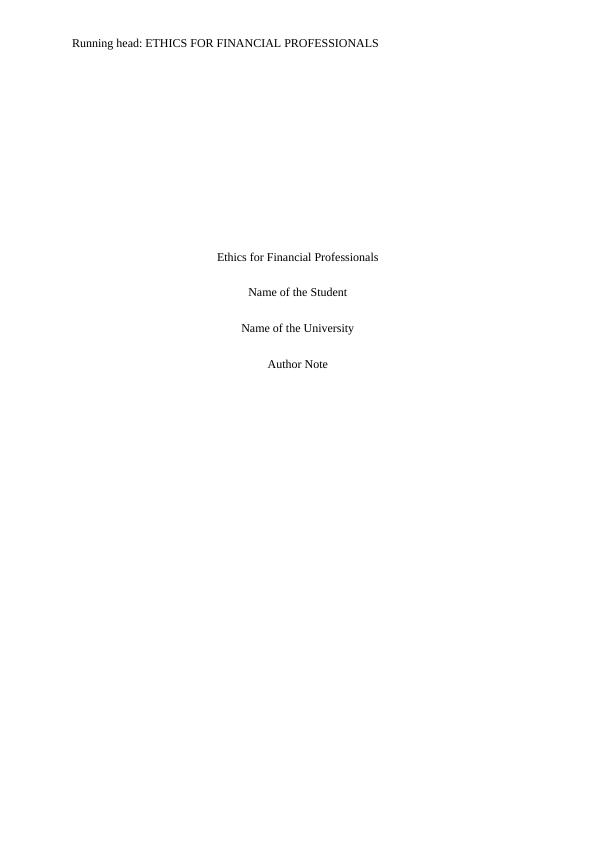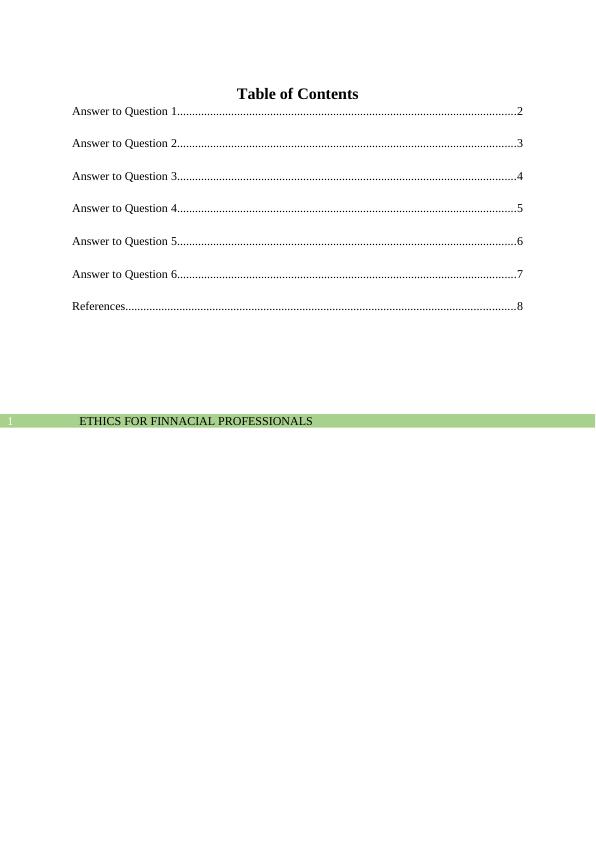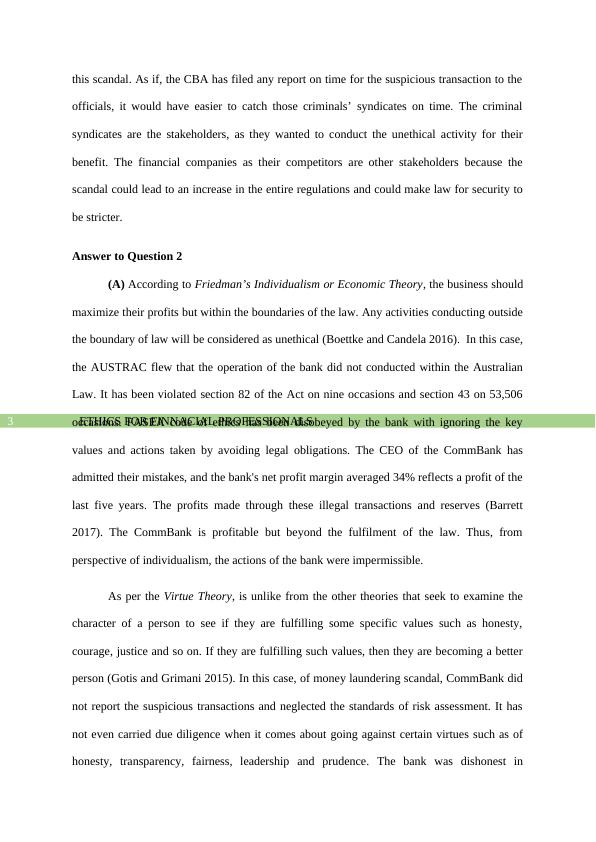Ethics for Financial Professionals
Added on 2022-08-31
11 Pages2779 Words21 Views
Running head: ETHICS FOR FINANCIAL PROFESSIONALS
Ethics for Financial Professionals
Name of the Student
Name of the University
Author Note
Ethics for Financial Professionals
Name of the Student
Name of the University
Author Note

ETHICS FOR FINNACIAL PROFESSIONALS1
Table of Contents
Answer to Question 1.................................................................................................................2
Answer to Question 2.................................................................................................................3
Answer to Question 3.................................................................................................................4
Answer to Question 4.................................................................................................................5
Answer to Question 5.................................................................................................................6
Answer to Question 6.................................................................................................................7
References..................................................................................................................................8
Table of Contents
Answer to Question 1.................................................................................................................2
Answer to Question 2.................................................................................................................3
Answer to Question 3.................................................................................................................4
Answer to Question 4.................................................................................................................5
Answer to Question 5.................................................................................................................6
Answer to Question 6.................................................................................................................7
References..................................................................................................................................8

ETHICS FOR FINNACIAL PROFESSIONALS2
Answer to Question 1
(A) The case study of CBA’s money laundering scandal reflects the violation of ethics
and standards related to the Australian Bank. The Commonwealth Bank of Australia got
involved its name in anti-money laundering (AML) and Counter-terrorist financing (CTF)
process that resulted in hundreds of millions of dollars laundered at an international level by
some criminals. The case is linked to the use of intelligent deposit machines as an ATM,
which has been launched in the year 2012 (Jacob 2012). The machine permits customers to
deposit and transfer their money anonymously even when the banks are closed. From the year
2012 to 2015, CBA has failed to provide a report of more than 53000 doubtful transactions to
AUSTRAC by using its ATM to establish on time. In this case, one of the most significant
financial institutions has created risk to a national risk after getting through a huge fine of
$700 million for breaking the regulations made within the AML and CTF.
Money laundering is a procedure of illegally making a large amount of money
through criminal activity such as terrorism funding, drug trafficking, and so on. The capital
formed through such a criminal or unlawful activity is considered as dirty and procedures
implemented to launder the money to make its appearance clean is completely unethical
(Godspower-Akpomiemie and Ojah 2018).
(B) The stakeholders, in this case, are those who have influenced by the ethics case.
The executive and the seniors of the bank could have avoided the whole scandal by using
their position so that to act ethically. The people working there as an employee and the
customers have affected through the negative publicity which is surrounded by the scandal.
People generally want to work for or to keep their money in the safe hands who avoid any
wrongdoings. Shareholders have a negative impact through this whole scandal in their
earnings and fluctuations in the stock price. The enforcement of law also affected because of
Answer to Question 1
(A) The case study of CBA’s money laundering scandal reflects the violation of ethics
and standards related to the Australian Bank. The Commonwealth Bank of Australia got
involved its name in anti-money laundering (AML) and Counter-terrorist financing (CTF)
process that resulted in hundreds of millions of dollars laundered at an international level by
some criminals. The case is linked to the use of intelligent deposit machines as an ATM,
which has been launched in the year 2012 (Jacob 2012). The machine permits customers to
deposit and transfer their money anonymously even when the banks are closed. From the year
2012 to 2015, CBA has failed to provide a report of more than 53000 doubtful transactions to
AUSTRAC by using its ATM to establish on time. In this case, one of the most significant
financial institutions has created risk to a national risk after getting through a huge fine of
$700 million for breaking the regulations made within the AML and CTF.
Money laundering is a procedure of illegally making a large amount of money
through criminal activity such as terrorism funding, drug trafficking, and so on. The capital
formed through such a criminal or unlawful activity is considered as dirty and procedures
implemented to launder the money to make its appearance clean is completely unethical
(Godspower-Akpomiemie and Ojah 2018).
(B) The stakeholders, in this case, are those who have influenced by the ethics case.
The executive and the seniors of the bank could have avoided the whole scandal by using
their position so that to act ethically. The people working there as an employee and the
customers have affected through the negative publicity which is surrounded by the scandal.
People generally want to work for or to keep their money in the safe hands who avoid any
wrongdoings. Shareholders have a negative impact through this whole scandal in their
earnings and fluctuations in the stock price. The enforcement of law also affected because of

ETHICS FOR FINNACIAL PROFESSIONALS3
this scandal. As if, the CBA has filed any report on time for the suspicious transaction to the
officials, it would have easier to catch those criminals’ syndicates on time. The criminal
syndicates are the stakeholders, as they wanted to conduct the unethical activity for their
benefit. The financial companies as their competitors are other stakeholders because the
scandal could lead to an increase in the entire regulations and could make law for security to
be stricter.
Answer to Question 2
(A) According to Friedman’s Individualism or Economic Theory, the business should
maximize their profits but within the boundaries of the law. Any activities conducting outside
the boundary of law will be considered as unethical (Boettke and Candela 2016). In this case,
the AUSTRAC flew that the operation of the bank did not conducted within the Australian
Law. It has been violated section 82 of the Act on nine occasions and section 43 on 53,506
occasions. FASEA code of ethics has been disobeyed by the bank with ignoring the key
values and actions taken by avoiding legal obligations. The CEO of the CommBank has
admitted their mistakes, and the bank's net profit margin averaged 34% reflects a profit of the
last five years. The profits made through these illegal transactions and reserves (Barrett
2017). The CommBank is profitable but beyond the fulfilment of the law. Thus, from
perspective of individualism, the actions of the bank were impermissible.
As per the Virtue Theory, is unlike from the other theories that seek to examine the
character of a person to see if they are fulfilling some specific values such as honesty,
courage, justice and so on. If they are fulfilling such values, then they are becoming a better
person (Gotis and Grimani 2015). In this case, of money laundering scandal, CommBank did
not report the suspicious transactions and neglected the standards of risk assessment. It has
not even carried due diligence when it comes about going against certain virtues such as of
honesty, transparency, fairness, leadership and prudence. The bank was dishonest in
this scandal. As if, the CBA has filed any report on time for the suspicious transaction to the
officials, it would have easier to catch those criminals’ syndicates on time. The criminal
syndicates are the stakeholders, as they wanted to conduct the unethical activity for their
benefit. The financial companies as their competitors are other stakeholders because the
scandal could lead to an increase in the entire regulations and could make law for security to
be stricter.
Answer to Question 2
(A) According to Friedman’s Individualism or Economic Theory, the business should
maximize their profits but within the boundaries of the law. Any activities conducting outside
the boundary of law will be considered as unethical (Boettke and Candela 2016). In this case,
the AUSTRAC flew that the operation of the bank did not conducted within the Australian
Law. It has been violated section 82 of the Act on nine occasions and section 43 on 53,506
occasions. FASEA code of ethics has been disobeyed by the bank with ignoring the key
values and actions taken by avoiding legal obligations. The CEO of the CommBank has
admitted their mistakes, and the bank's net profit margin averaged 34% reflects a profit of the
last five years. The profits made through these illegal transactions and reserves (Barrett
2017). The CommBank is profitable but beyond the fulfilment of the law. Thus, from
perspective of individualism, the actions of the bank were impermissible.
As per the Virtue Theory, is unlike from the other theories that seek to examine the
character of a person to see if they are fulfilling some specific values such as honesty,
courage, justice and so on. If they are fulfilling such values, then they are becoming a better
person (Gotis and Grimani 2015). In this case, of money laundering scandal, CommBank did
not report the suspicious transactions and neglected the standards of risk assessment. It has
not even carried due diligence when it comes about going against certain virtues such as of
honesty, transparency, fairness, leadership and prudence. The bank was dishonest in

End of preview
Want to access all the pages? Upload your documents or become a member.
Related Documents
Commonwealth Bank of Australia (CBA) Money Laundering Scandallg...
|10
|2949
|468
CBA Money Laundering Scandallg...
|10
|2310
|15
ACC80005 Financial Accounting Theorylg...
|17
|4963
|59
Law of Financial Institution and Security: Assignmentlg...
|11
|2786
|127
Information System for Business Professionalslg...
|10
|1962
|214
CBA Fraud and Money Laundering Case Studylg...
|13
|3303
|300